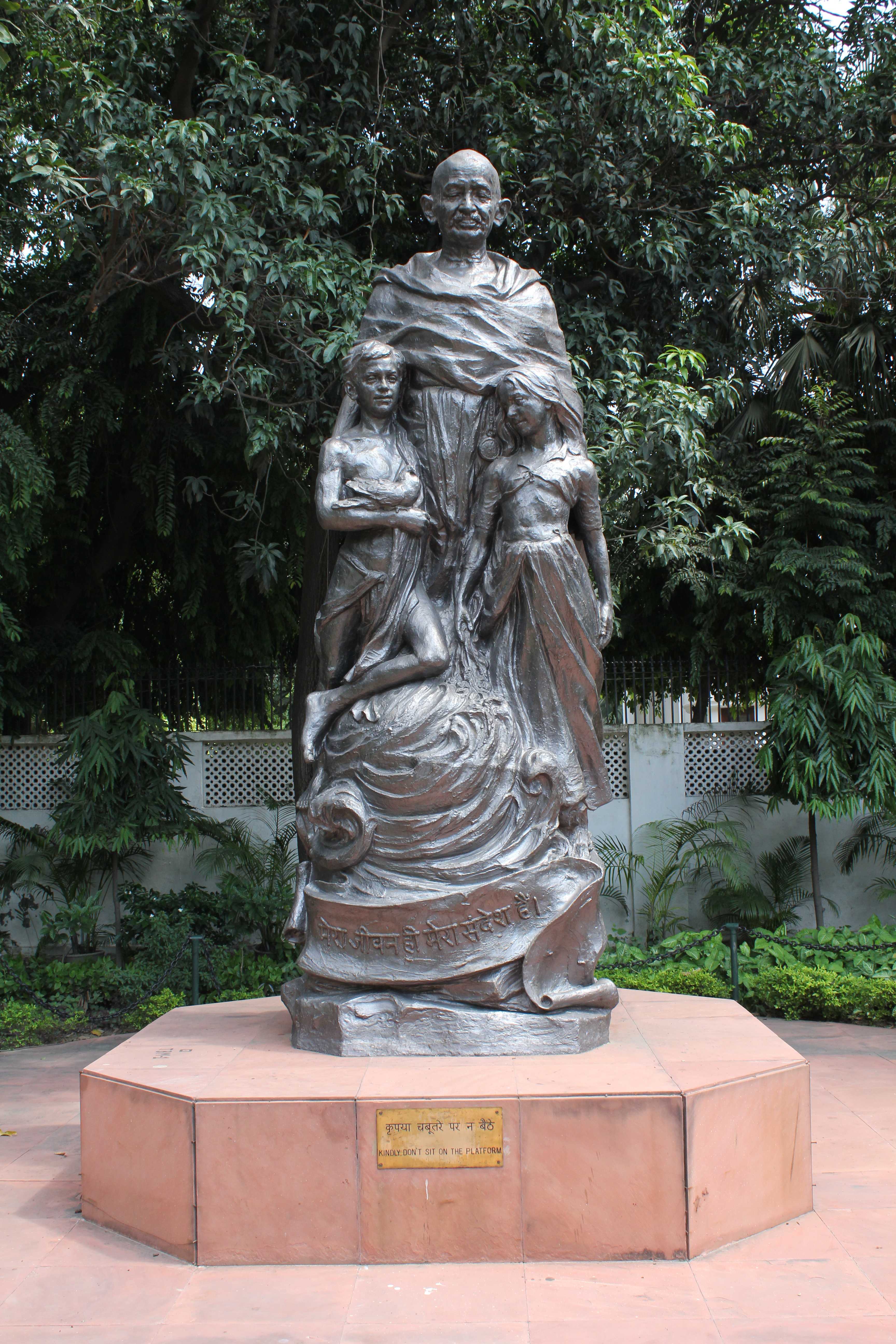Gandhi Smriti and Darshan Samiti: A Profile
Gandhi Smriti and Darshan Samiti (GSDS) was formed in September 1984 by the merger of Gandhi Darshan at Rajghat and Gandhi Smriti, at 5, Tees January Marg as an autonomous body, and is functioning under the constructive advice and financial support from the Ministry of Culture, Government of India. The Prime Minister of India is its Chairperson and it has a nominated body of senior Gandhians and representatives of various government departments to guide it in its activities. The basic aim and objective of the Samiti are to propagate the life, mission and thought of Mahatma Gandhi through various socio-educational and cultural programmes.
The Samiti has two campuses:

Gandhi Smriti
Gandhi Smriti, housed in the Old Birla House on 5, Tees January Marg, New Delhi, is the sacred place where Mahatma Gandhi’s epic Life ended on 30 January 1948. Mahatma Gandhi had lived in this house on September 9, 1947, to January 30, 1948. Thus, the hallowed house treasures many memories of the last 144 days of his life. The Old Birla House was acquired by the Government of India in 1971 and was converted into a National Memorial of the Father of the Nation and was opened to the public on August 15, 1973.
The preserves include the room where Gandhiji lived and the prayer ground where mass congregation used to be held. This was the place where Gandhiji was felled by the assassin’s bullets. The building and the landscape have been preserved as they were in those days.

The Memorial consists of:
- Visual Aspects to perpetuate the memory of Mahatma Gandhi and the noble ideals they represented,
- Educative Aspects to focus concentrated attention on certain values of life that made Gandhi a Mahatma and
- Service Aspects to introduce activities in order to sub-serve certain felt needs.
On display in the Museum are photographs, sculptures, paintings, frescos, inscriptions on rocks and relics pertaining to the years Gandhiji spent here. The meager personal effects of Gandhiji too are carefully preserved.
The entrance gate itself is of great historical significance as it was from the top of this Gate Prime Minister Jawaharlal Nehru announced to the World about the passing away of Mahatma Gandhi, “… the light has gone out our lives and there is darkness everywhere…”
A larger than life statue of Mahatma Gandhi, with a boy and a girl holding a dove in their hands, standing on either side, emerging out of the globe, symbolizing his universal concern for the poor and the deprived, welcomes the visitor at the main entrance of the Gandhi Smriti. It is the work of the renowned sculptor Sri Ram Sutar. The legend at the base of the sculpture says, “My Life is My Message”.

A Martyr’s Column stands at the spot where the Father of the Nation was assassinated, commemorating the Martyrdom of Mahatma Gandhi as the embodiment of all the sufferings and sacrifices that characterized the long struggle for India’s Freedom. A broad stone pavement is laid around the Column for devotees to take a reverential parikrama (walk around). The wide space in front of the Column is made for devotees to offer homage. Close to the Martyr’s Column on the lower lawns are the words of Gurudev Tagore, “He stopped at the threshold of every hut…”
In the Centre of the Prayer Ground, is a Pavilion with frescos on the walls, depicting the continuity of India’s cultural voyage, her interaction across the globe and the emergence of Mahatma Gandhi as a ‘Universal Man’, embodying in his person all that is sublime in human life as he said: ‘For my material needs my village is my world but for my spiritual needs the whole world is my village’.
Outside the Pavilion there is a bench, made of red sandstone on which Mahatma Gandhi used to sit during the prayer or in conversation with the vast mass of humanity who would assemble on the lawns of the Old Birla House seeking his counsel and solace in those troubled days.
The green lawns are the main feature of the Prayer Ground with peripheral decorations with flowers laid around the lawn. Near the entrance of the memorial on its right lawn is inscribed “India of Gandhi’s dream”. At the roundabout close to the prayer ground are the words of Albert Einstein, “Generations to come will scarce believe…” In the center of the roundabout is a creation of the renowned artist Sankho Chowdhury in bronze, symbolizing the ‘Eternal Flame’ lit by Gandhi with his martyrdom.
Gandhiji’s Room at Gandhi Smriti has been kept exactly as it was on the day of his assassination. All his possessions are on display: his glasses, walking stick, a knife, fork and spoon, the rough stone he used instead of soap. His bed was a mattress on the floor, plain white, with a low, wooden desk by its side. There is also an old and well-used copy of the Gita.
The entire building is now divided into different sections. On either side of the main entrance of the building a Prayer composed by the Mahatma ‘A Servants Prayer’ and his eternal message, His ‘Talisman’ are on display.

The evolution of Mohandas Karamchand Gandhi to Mahatma Gandhi is depicted in the south wing through the panels of black and white photographs accompanied by a simple narrative. The south wing also houses an auditorium and a committee room.
Besides, the exhibition has been so aligned that the south wing gives a simple narration of the journey and evolution of a boy called Mohandas Karamchand Gandhi and how through his ‘experiments with truth’, he leads India and humanity to its emancipation.
The northern wing has five different sections. The first section, the gallery leading towards the room where Gandhiji spent the last 144 days of his life is devoted to his Peace Pilgrimage and Martyrdom. Next to this is the second section, another room with the special focus on the last 48 hours of his life, which culminates with his martyrdom. This section has also an auditorium with facilities to screen films on Mahatma Gandhi.

The third section of the north wing projects the ‘India of Gandhi’s Dreams’ and the formulae he has left behind for posterity to realize this dream: the Eighteen Point Constructive Programme. Gandhi wanted to present India as a model of development before the world with scientific precision. The epic journey ends – Father of the Nation is gone. But his legacy lives on. Above all, an unfulfilled dream remains a challenge before us to build the ‘India’ of his ‘dreams’.
The fourth section Sumana has twenty-eight enclosures/panels in all. The section, which is today, houses the Minifigures. These powerful dioramas depict important events in the life of Mahatma Gandhi from his boyhood to his martyrdom. Crafted by Smt. Sushila Rajni Patel, this section of the Museum is an enriching experience.

In the fifth section Sanmati, the Gandhi Smriti literature centre, there is a vast collection of Gandhiana and other related and relevant books available under one roof.
A special section is devoted to explaining how the world reveres Mahatma Gandhi. The first part is through the eyes of the artists reflecting the magnificent life of the Mahatma. The second part is Gandhi on himself.
In the centre, people are led to assimilate, absorb and feel the presence of the Mahatma through a 40-second multi-media animation, depicting the last journey of the Father of the Nation towards his Martyrdom. This is depicted through the rendition by one of the renowned vocalists Kumar Gandharva.

The pergola – which provides an interface with the visiting mass of humanity –is now a walking art gallery, which provides an opportunity to artists from all segments of our society and all parts of the world to witness the journey of Mohandas Karamchand Gandhi to Mahatma Gandhi in the sprawling exhibition From Mohan to Mahatma prepared by senior Gandhians like Shri Anupam Misra and developed by the National Archives of India. The exhibition was inaugurated by the Hon’ble Minister of Culture and VC GSDS Dr. Mahesh Sharma on the occasion of Gandhi Jayanti on October 2, 2015, in Gandhi Smriti.

While on their journey, the visitors also witness the magnificent World Peace Gong that stands to face the rooftop where the mortal remains of the father of the nation were kept on January 31, 1948, for thousands of people to pay their last tributes. The Peace Gong, gifted to Gandhi Smriti by the Ministry of External Affairs, Government of India after being received from the World Peace Gong Committee of Indonesia was inaugurated at a special function commemorating the 100 years of Satyagraha on September 11, 2006. This is a gentle reminder to the world of the enormous struggles by peace marchers across the world to live in harmony with one another.
From here the visitors are guided into the room where Bapuji spent the last 144 days of his life. As they come out of this room they are acquainted with the history of these 144 days through the Photo Exhibition accompanied by narratives culled out from the accounts of the eyewitnesses. Swaraj at Gandhi Smriti showcases Gandhian emphasis on khadi, cottage industries, and rural development.

The Kirti Mandap pandal christened by the eminent Sarod Player Ustad Amjad Ali Khan, near the Martyr’s Column at Gandhi Smriti has the capacity to accommodate 500 participants for major programmes.
In an endeavor to provide the underprivileged section of the social skills in computer, stitching and embroidery, early childhood care and education, community health, spinning and weaving, mime and music, Srijan – the Gandhi Smriti Educational Centre – has been set up at Gandhi Smriti. Srijan aims to help them learn these vocational courses in order to instill in them the appreciation for self-help, confidence and bread-labor.
The museum added in April 2005 a multimedia exhibition entitled Eternal Gandhi, which is housed on the entire first floor of the building. It has used state-of-the-art electronic hardware and new media to bring Gandhiji’s life and vision alive. The approach has been both historical and interpretative. This exhibition using 21st-century technology highlights the core of Gandhian thought – the commitment of a Satyagrahi to the principles of truth. Two sculptures of Ba and Bapu made in organized, which are the creations of a couple, Mr. Decha Saisomboon and Mrs. Wipa Saisomboon from Thailand, are also kept at the multi-media museum.
It is these components that together make Gandhi Smriti a Composite Museum.












